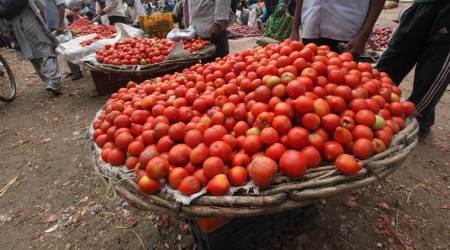 Vanita grows lady’s fingers, cluster beans, cucumbers, pumpkins and bitter gourd. Dilip Kagda
Vanita grows lady’s fingers, cluster beans, cucumbers, pumpkins and bitter gourd. Dilip Kagda
While farmers continue to feature in news and television debates, Vanita Thakre, a tribal from the Warli community living in the forests of the Aarey Milk Colony, may not be among those that come to mind at once. On the green patch surrounded by concrete-riddled western suburbs of Mumbai, the Aarey Milk Colony is home to families who farm for a living. And like the farming community elsewhere in the state, they look forward to every monsoon.
Thakre, like most of the tribals in Aarey, grows vegetables in her small farm and sells them in the nearby market in Andheri (East). Starting May, Thakre begins preparing the seeds for sowing and as the monsoon approaches she sows them in her vegetable farm.
“In two-three months, the vegetables are ready and I get a good harvest for at least three to four months until the plant dies,” says Thakre. Among the different vegetables she grows are lady’s finger, cluster beans, cucumber, pumpkin and bitter gourd. She harvests them early morning and takes them on her head to the Vijay Nagar market. Selling around 10 kg in a day, she makes around Rs 500 per day.
“I have to reach there by 9 am otherwise, there is no space left to sit. We sell there until 1 pm when the crowd begins to thin. If we still have vegetables left, then we walk around in the neighbourhood, calling out to people to buy them at cheaper prices,” adds the 35-year-old farmer.
Thakre uses only natural fertilisers and pesticides. She uses cow dung as fertiliser and the burnt ash from the kitchen firewood as pesticide. “We are not aware of the other medicines that can be used. These are natural products that farmers have traditionally used for their crops. We do not even procure the seeds from outside and instead collect them from our own harvest,” she says.
The tribal community in Aarey has demarcated different markets for selling their produce according to their area. “Tribals living at Picnic Point sell at Marol, those at Keltipada go to Jogeshwari and others like us from Khambachapada go to Vijay Nagar,” she explains.
Thakre also does paddy cultivation. Sowing them in the monsoon, she harvests them by Diwali. “I do not sell the rice in the market and only grow it for the family. Since our land is not too big, we do not manage to grow for the whole year’s need, but it suffices for at least three to four months. It is still cheaper and better when it is grown at home,” she says. Farming is a family affair for the Thakres, with her three children also helping in the field. Her husband works as a gardener in an apartment complex in Aarey but he also pitches in on his off days. Owing to a lack of irrigation system, Vanita can indulge in farming activities only during the monsoon. During the rest of the year, she takes on odd jobs, like collecting firewood from the forests, cutting grass for the stables or working at a construction site.

